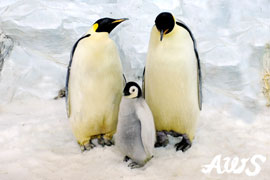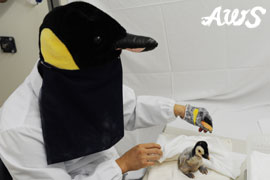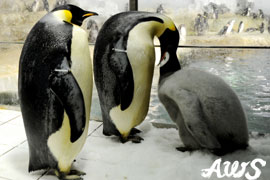Safari&Marineエンペラーペンギン 自然育雛の成功まで

●2012年の失敗と2013年の成功へのステップ●
エンペラーペンギンは不安定な足の上で卵を抱きヒナを育てます。そのため卵が割れたり、ヒナが押しつぶされたりと、巣を作るペンギンに比べて育成率は高くありません。これまでは確実にヒナを成育させるため、2004年から2011年までに生まれた6羽は全て“人工育雛(人が親代わりになり育てること)”をして成功してきました。これで、“人工育雛技術の確立”はできたものの、“人への刷り込み(生まれて最初に動く物体を親として覚え込む現象)”もみられました。
このままでは、将来の繁殖に繋がらないのではないかと考え、2012年から“自然育雛(親鳥に育てさせること)”に挑戦することにしました。
2012年は、孵化後10日の初期のみ人工育雛をした後、親鳥に戻しました。しかし、24時間観察しても親鳥からの給餌は確認できなかったため、自然育雛を断念し再び人工育雛に切り替えました。親鳥から給餌がみられなかった原因として、『初期人工育雛時に人への刷り込みがあったことで、ヒナの親鳥への餌の要求が少ないのではないか』ということが考えられました。

2013年は、親鳥を子育てスペースに早く慣らすこと、そしてヒナが人に刷り込みしない工夫をする、この2点を改善事項にしました。人への刷り込み防止の対策として、人工育雛する際のペンギン型の帽子と手袋の着用と、親鳥の鳴声を流しながらの給餌を行うことにしました。

●2013年のチャレンジ●
2013年、いよいよ自然育雛2回目の挑戦です。10月17日に277gで生まれたヒナを人工育雛し、孵化後12日、体重479gで親鳥の元へと戻しました。48時間観察しましたが、やはり親鳥からの給餌がみられません。もう少しヒナの体がしっかりしてから再チャレンジするため、一旦人工育雛へと切り替えました。孵化後21日、体重773gまで成長したため再度親鳥に戻しましたが、相変わらず給餌は認められません。ところが前回よりもヒナの親鳥への餌の要求が多かったため、親鳥にヒナを抱かせたままスタッフが餌を与える“介添え給餌”で様子を見ることにしました。その後も親鳥からの給餌は確認できません。 「やはり自然育雛は不可能なのか」と思い始めた5日後の11月12日の朝、体重を量ると昨晩の体重からの減少がありませんでした。自分の目を疑いましたが、何度量っても同じ数値でした。「もしかしたら……。」という思いで、この日はヒナに餌を与えることをやめました。
しかし翌日の体重も増えていたため、この時点で親鳥が餌を与えていることは確信へと変わりました。それでも給餌をしている姿が全く確認できません。ビデオカメラを設置して夜間の確認をしようと考え、夕方に展示場へ向かったところ、まさに親鳥がヒナに餌を与えている瞬間を目の当たりにしました。
手が震えながらもその姿を撮影することにも成功しました。このときの喜び、感動は今も忘れられません。確信がついに真実へ変わった瞬間でした。親鳥からの給餌が確認できてから孵化後50日あたりまでは、これまでの人工育雛時の成長と同じくらいの体重増加でした。それ以降は人工育雛時の成長曲線を大幅に上回り、親鳥からの給餌のみで順調に成長していきました。生後半年以上が経ち、体重は約25kgまで成長し、今では親鳥からも巣立ちし、元気にプールで泳いでいます。
2012年の失敗を基に改善策を考えて実施したことが、自然育雛成功に繋がりました。今後は、より早期にヒナを親元に戻すことが目標です。
(津久井健太)

